Immobilized Lipase in Resolution of Ketoprofen Enantiomers: Examination of Biocatalysts Properties and Process Characterization
Abstract
:1. Introduction
2. Materials and Methods
2.1. Chemicals and Materials
2.2. Lipase Immobilization by Physical Immobilization by the Adsorption Interactions and Partially Interfacial Activation and Mixed Physical Immobilization via Interfacial Activation and Ion Exchange
2.3. Effect of Reaction Parameters (pH, T), Storage Stability, Thermal Stability, and Reusability
2.4. Immobilization Yield, Amount of Immobilized Enzyme, and Specific Activity
2.5. Synthesis of Racemic Ketoprofen Methyl Ester
2.6. Enzymatic Resolution of Racemic Ketoprofen Methyl Ester
2.7. Physicochemical Characterisation
2.8. Efficiency and Enantiomeric Excess of the Kinetic Resolution Process of the Racemic Mixture
3. Results and Discussion
3.1. Characterisation of the Produced Biocatalytic Systems
3.2. Parameters Affecting Enzymes Activity
3.3. Enzymatic Resolution of Racemic Ketoprofen
4. Conclusions
Author Contributions
Funding
Institutional Review Board Statement
Informed Consent Statement
Data Availability Statement
Acknowledgments
Conflicts of Interest
References
- Vonkeman, H.E.; van de Laar, M.A. Nonsteroidal anti-inflammatory drugs: Adverse effects and their prevention. Semin. Arthritis Rheum. 2010, 39, 294–312. [Google Scholar] [CrossRef] [PubMed]
- Patel, R. Biocatalysis: Synthesis of Key Intermediates for Development of Pharmaceuticals. ACS Catal. 2011, 1, 1056–1074. [Google Scholar] [CrossRef]
- Kim, J.H.; Scialli, A.R. Thalidomide: The Tragedy of Birth Defects and the Effective Treatment of Disease. Toxicol. Sci. 2011, 122, 1–6. [Google Scholar] [CrossRef] [PubMed] [Green Version]
- Brune, K.; Patrignani, P. New insights into the use of currently available non-steroidal anti-inflammatory drugs. J. Pain Res. 2015, 8, 105. [Google Scholar] [CrossRef] [PubMed] [Green Version]
- Dhokchawle, B.; Tauro, S.; Bhandari, A. Ester prodrugs of ketoprofen: Synthesis, hydrolysis kinetics and pharmacolocical evaluation. Drug Res. 2015, 66, 46–50. [Google Scholar] [CrossRef] [PubMed]
- Ong, A.L.; Kamaruddin, A.H.; Bhatia, S.; Aboul-Enein, H.Y. Enantioseparation of (R,S)-ketoprofen using Candida antarctica lipase B in an enzymatic membrane reactor. J. Sep. Sci. 2008, 31, 2476–2485. [Google Scholar] [CrossRef]
- Truppo, M.D. Biocatalysis in the pharmaceutical industry: The Need for Speed. ACS Med. Chem. Lett. 2017, 8, 476–480. [Google Scholar] [CrossRef] [Green Version]
- Wu, S.; Snajdrova, R.; Moore, J.C.; Baldenius, K.; Bornscheuer, U. Biocatalysis: Enzymatic synthesis for industrial applications. Angew. Chem. Int. Ed. 2020, 60, 88–119. [Google Scholar] [CrossRef]
- Burke, A.J.; Marques, C.S.; Turner, N.J.; Hermann, G.J. Active Pharmaceutical Ingredients in Synthesis Catalytic Processes in Research and Development; Wiley-VCH: Weinheim, Germany, 2018. [Google Scholar]
- Bezborodov, A.M.; Zagustina, N.A. Enzymatic biocatalysis in chemical synthesis of pharmaceuticals. Appl. Biochem. Microbiol. 2016, 52, 237–249. [Google Scholar] [CrossRef]
- Simon, R.C.; Mutti, F.G.; Kroutil, W. Biocatalytic synthesis of enantiopure building blocks for pharmaceuticals. Drug Discov. Today Technol. 2014, 10, e37–e44. [Google Scholar] [CrossRef]
- Derewenda, Z.S.; Sharp, A.M. News from the interface: The molecular structures of triacyglyceride lipases. Trends Biochem. Sci. 1993, 18, 20–25. [Google Scholar] [CrossRef]
- Brzozowski, A.M.; Derewenda, U.; Derewenda, Z.S.; Dodson, G.G.; Lawson, D.M.; Turkenburg, J.P.; Thim, L. A model for interfacial activation in lipases from the structure of a fungal lipase-inhibitor complex. Nature 1991, 351, 491–494. [Google Scholar] [CrossRef] [PubMed]
- Verger, R. Interfacial activation of lipases: Facts and artifacts. Trends Biotechnol. 1997, 15, 32–38. [Google Scholar] [CrossRef]
- Contesini, F.J.; Davanço, M.G.; Borin, G.P.; Vanegas, K.G.; Cirino, J.P.; Melo, R.R.; Mortensen, U.H.; Hildén, K.; Campos, D.R.; Carvalho, P.D. Advances in recombinant lipases: Production, engineering, immobilization and application in the pharmaceutical industry. Catalysts 2020, 10, 1032. [Google Scholar] [CrossRef]
- Adham, N.Z.; Ahmed, E.M. Extracellular lipase of Aspergillus niger NRRL3; Production, partial purification and properties. Indian J. Microbiol. 2009, 49, 77–83. [Google Scholar] [CrossRef] [PubMed] [Green Version]
- Nikalje, A.P.; Tathe, A.C.; Ghodke, M.S. Biocatalysis: A brief review. Asian J. Chem. 2011, 4, 1355–1360. [Google Scholar]
- Bornscheuer, U.T.; Kazlauskas, R.J. Hydrolases in Organic Synthesis; Wiley-VCH: Weinheim, Germany, 2006. [Google Scholar]
- Estrada-Valenzuela, D.; Ramos-Sánchez, V.H.; Zaragoza-Galán, G.; Espinoza-Hicks, J.C.; Bugarin, A.; Chávez-Flores, D. Lipase assisted (S)-ketoprofen resolution from commercially available racemic mixture. Pharmaceuticals 2021, 14, 996. [Google Scholar] [CrossRef]
- Mohammadi, M.; Ramazani, A.; Garmroodi, M.; Yousefi, M.; Yazdi, A.; Esfahani, K. Resolution of ibuprofen enantiomers by Rhizomucor miehei lipase (RML) immobilized via physical and covalent attachment. Modares J. Biotechnol. 2019, 10, 351–361. [Google Scholar]
- Grunwald, P. Pharmaceutical Biocatalysis: Chemoenzymatic Synthesis of Active Pharmaceutical Ingredients; Jenny Stanford Publishing: Singapore, 2019. [Google Scholar]
- Piacentini, E.; Mazzei, R.; Giorno, L. Comparison between Lipase Performance Distributed at the O/W Interface by Membrane Emulsification and by Mechanical Stirring. Membranes 2021, 11, 137. [Google Scholar] [CrossRef]
- Thangaraj, B.; Solomon, P.R. Immobilization of lipases—A review. Part I: Enzyme immobilization. ChemBioEng Rev. 2019, 5, 157–166. [Google Scholar] [CrossRef]
- Shuai, W.; Das, R.K.; Naghdi, M.; Brar, S.K.; Verma, M. A review on the important aspects of lipase immobilization on nanomaterials. Biotechnol. Appl. Biochem. 2017, 64, 496–508. [Google Scholar] [CrossRef] [PubMed]
- Mateo, C.; Palomo, J.M.; Fernandez-Lorente, G.; Guisan, J.M.; Fernandez-Lafuente, R. Improvement of enzyme activity, stability and selectivity via immobilization techniques. Enzyme Microb. Technol. 2007, 40, 1451–1463. [Google Scholar] [CrossRef]
- Khan, A.A.; Akhtar, S.; Husain, Q. Simultaneous purification and immobilization of mushroom tyrosinase on an immunoaffinity support. Process Biochem. 2005, 40, 2379–2386. [Google Scholar] [CrossRef]
- Akhtar, S.; Khan, A.A.; Husain, Q. Simultaneous purification and immobilization of bitter gourd (Momordica charantia) peroxidases on bioaffinity support. J. Chem. Technol. Biotechnol. 2005, 80, 198–205. [Google Scholar] [CrossRef]
- Rodrigues, R.C.; Berenguer-Murcia, Á.; Carballares, D.; Morellon-Sterling, R.; Fernandez-Lafuente, R. Stabilization of enzymes via immobilization: Multipoint covalent attachment and other stabilization strategies. Biotechnol. Adv. 2021, 52, 107821. [Google Scholar] [CrossRef]
- Rodrigues, R.C.; Ortiz, C.; Berenguer-Murcia, Á.; Torres, R.; Fernández-Lafuente, R. Modifying enzyme activity and selectivity by immobilization. Chem. Soc. Rev. 2013, 42, 6290–6307. [Google Scholar] [CrossRef]
- Garcia-Galan, C.; Berenguer-Murcia, Á.; Fernandez-Lafuente, R.; Rodrigues, R.C. Potential of different enzyme immobilization strategies to improve enzyme performance. Adv. Synth. Catal. 2011, 353, 2885–2904. [Google Scholar] [CrossRef]
- Contesini, F.J.; Lopes, D.B.; Macedo, G.A.; da Graça Nascimento, M.; de Oliveira Carvalho, P. Aspergillus sp. lipase: Potential biocatalyst for industrial use. J. Mol. Catal. B Enzym. 2010, 67, 163–171. [Google Scholar] [CrossRef]
- Kavitha, K.; Shankari, K.; Meenambiga, S.S. A review on extraction of lipase from aspergillus species and its applications. Res. J. Pharm. Technol. 2021, 14, 4471–4475. [Google Scholar]
- Foresti, M.L.; Galle, M.; Ferreira, M.L.; Briand, L.E. Enantioselective esterification of ibuprofen with ethanol as reactant and solvent catalyzed by immobilized lipase: Experimental and molecular modeling aspects. J. Chem. Technol. Biotechnol. 2009, 84, 1461–1473. [Google Scholar] [CrossRef]
- Wang, S.-Z.; Wu, J.-P.; Xu, G.; Yang, L.-R. Chemo-enzymatic asymmetric synthesis of S-citalopram by lipase-catalyzed cyclic resolution and stereoinversion of quaternary stereogenic center. Bioprocess Biosyst. Eng. 2012, 36, 1031–1037. [Google Scholar] [CrossRef] [PubMed]
- Bradford, M.M. A rapid and sensitive method for the quantitation of microgram quantities of protein utilizing the principle of protein-dye binding. Anal. Biochem. 1976, 72, 248–254. [Google Scholar] [CrossRef]
- Barbosa, O.; Torres, R.; Ortiz, C.; Berenguer-Murcia, Á.; Rodrigues, R.C.; Fernandez-Lafuente, R. Heterofunctional Supports in Enzyme Immobilization: From Traditional Immobilization Protocols to Opportunities in Tuning Enzyme Properties. Biomacromolecules 2013, 14, 2433–2462. [Google Scholar] [CrossRef] [PubMed] [Green Version]
- Kharrat, N.; Ali, Y.B.; Marzouk, S.; Gargouri, Y.-T.; Karra-Châabouni, M. Immobilization of Rhizopus oryzae lipase on silica aerogels by adsorption: Comparison with the free enzyme. Process Biochem. 2011, 46, 1083–1089. [Google Scholar] [CrossRef]
- Tan, Z.; Bilal, M.; Li, X.; Ju, J.; Teng, Y.; Iqbal, H.M.N. Nanomaterial-immobilized lipases for sustainable recovery of biodiesel—A review. Fuel 2022, 123429, 316. [Google Scholar] [CrossRef]
- Zdarta, J.; Sałek, K.; Kołodziejczak-Radzimska, A.; Siwińska-Stefańska, K.; Szwarc-Rzepka, K.; Norman, M.; Jesionowski, T. Immobilization of Amano Lipase A onto Stöber silica surface: Process characterization and kinetic studies. Open Chem. 2014, 13, 138–148. [Google Scholar] [CrossRef]
- Collins, S.E.; Lassalle, V.; Ferreira, M.L. FTIR-ATR characterization of free Rhizomucor meihei lipase (RML), Lipozyme RM IM and chitosan-immobilized RML. J. Mol. Catal. B Enzym. 2011, 72, 220–228. [Google Scholar] [CrossRef]
- Foresti, M.L.; Valle, G.; Bonetto, R.; Ferreira, M.L.; Briand, L.E. FTIR, SEM and fractal dimension characterization of lipase B from Candida antarctica immobilized onto titania at selected conditions. Appl. Surf. Sci. 2010, 256, 1624–1635. [Google Scholar] [CrossRef]
- Bódalo, A.; Bastida, J.; Máximo, M.F. A comparative study of free and immobilized soybean and horseradish peroxidases for 4-chlorophenol removal: Protective effects of immobilization. Bioprocess Biosys. Eng. 2008, 31, 587–593. [Google Scholar] [CrossRef]
- Pinheiro, B.B.; Rios, N.S.; Aguado, E.R.; Fernandez-Lafuente, R.; Freire, T.M.; Fechine, P.B.; Dos Santos, J.C.; Goncalves, L.R. Chitosan activated with divinyl sulfone: A new heterofunctional support for enzyme immobilization. Application in the immobilization of lipase B from Candida antarctica. Int. J. Biol. Macromol. 2019, 130, 798–809. [Google Scholar] [CrossRef]
- Ismail, A.R.; Baek, K.-H. Lipase immobilization with support materials, preparation techniques, and applications: Present and future aspects. Int. J. Biol. Macromol. 2020, 163, 1624–1639. [Google Scholar] [CrossRef] [PubMed]
- Ma, X.; Kexin, Z.; Yonggang, W.; Ebadi, A.; Toughani, M. Optimization of low-temperature lipase production conditions and study on enzymatic properties of Aspergillus Niger. Iran. J. Chem. Chem. Eng. 2021, 40, 1364–1374. [Google Scholar]
- Zdarta, J.; Jankowska, K.; Bachosz, K.; Kijeńska-Gawrońska, E.; Zgoła-Grześkowiak, A.; Kaczorek, E.; Jesionowski, T. A promising laccase immobilization using electrospun materials for biocatalytic degradation of tetracycline: Effect of process conditions and catalytic pathways. Catal. Today 2019, 348, 127–136. [Google Scholar] [CrossRef]
- Zdarta, J.; Norman, M.; Smułek, W.; Moszyński, D.; Kaczorek, E.; Stelling, A.; Jesionowski, T. Spongin-based scaffolds from Hippospongia communis demosponge as an effective support for lipase immobilization. Catalysts 2017, 7, 147. [Google Scholar] [CrossRef]
- Jiang, Y.; Zhai, J.; Zhou, L.; He, Y.; Ma, L.; Gao, J. Enzyme-silica hybrid nanoflowers shielding in polydopamine layer for the improvement of enzyme stability. Biochem. Eng. J. 2018, 132, 196–205. [Google Scholar] [CrossRef]
- Toledo, M.V.; Briand, L.E. Relevance and bio-catalytic strategies for the kinetic resolution of ketoprofen towards dexketoprofen. Crit. Rev. Biotechnol. 2017, 38, 778–800. [Google Scholar] [CrossRef] [PubMed]
- Ong, A.L.; Kamaruddin, A.H.; Bhatia, S.; Long, W.S.; Lim, S.T.; Kumari, R. Performance of free Candida antarctica lipase B in the enantioselective esterification of (R)-ketoprofen. Enzyme Microb. Technol. 2006, 39, 924–929. [Google Scholar] [CrossRef]
- Li, X.; Liu, T.; Xu, L.; Gui, X.; Su, F.; Yan, Y. Resolution of racemic ketoprofen in organic solvents by lipase from Burkholderia cepacia G63. Biotechnol. Bioprocess Eng. 2012, 17, 1147–1155. [Google Scholar] [CrossRef]
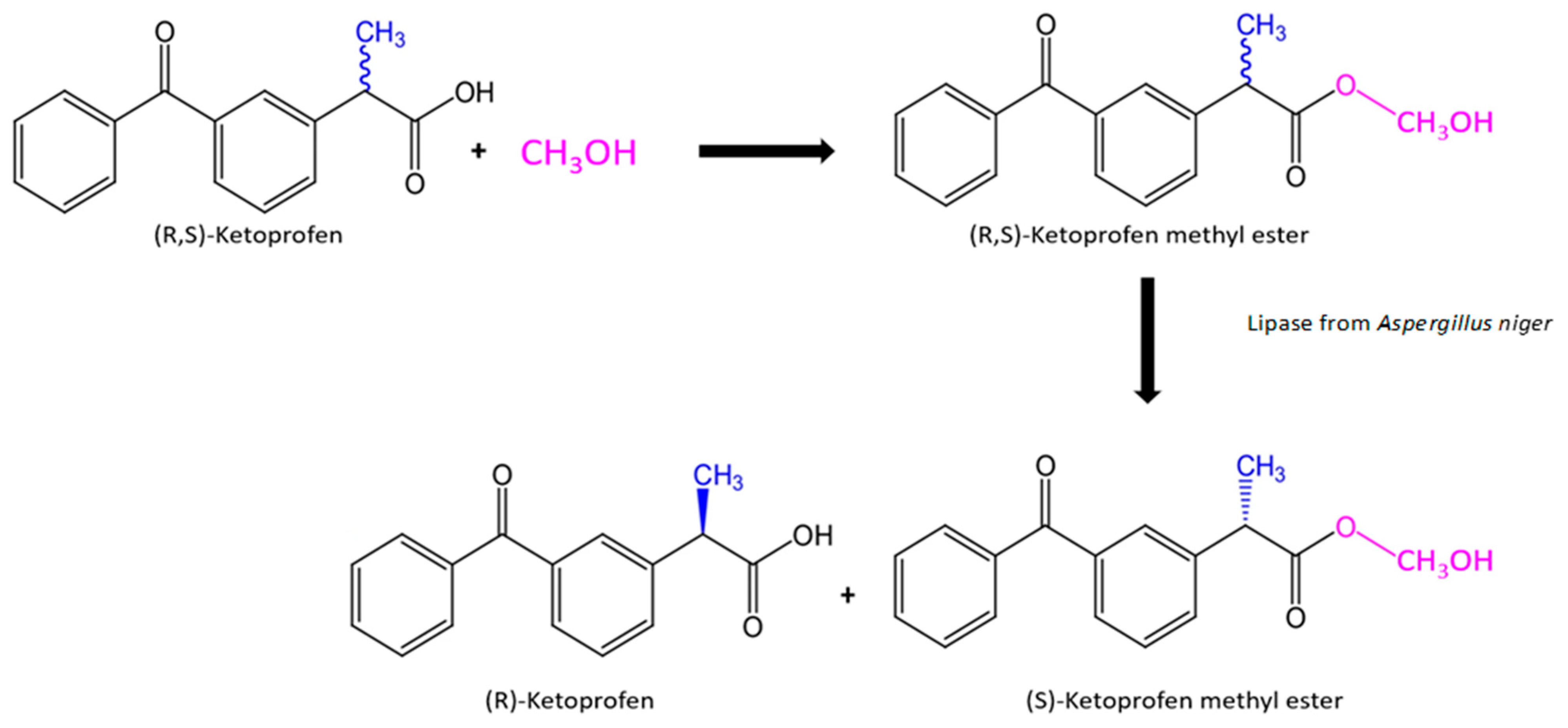
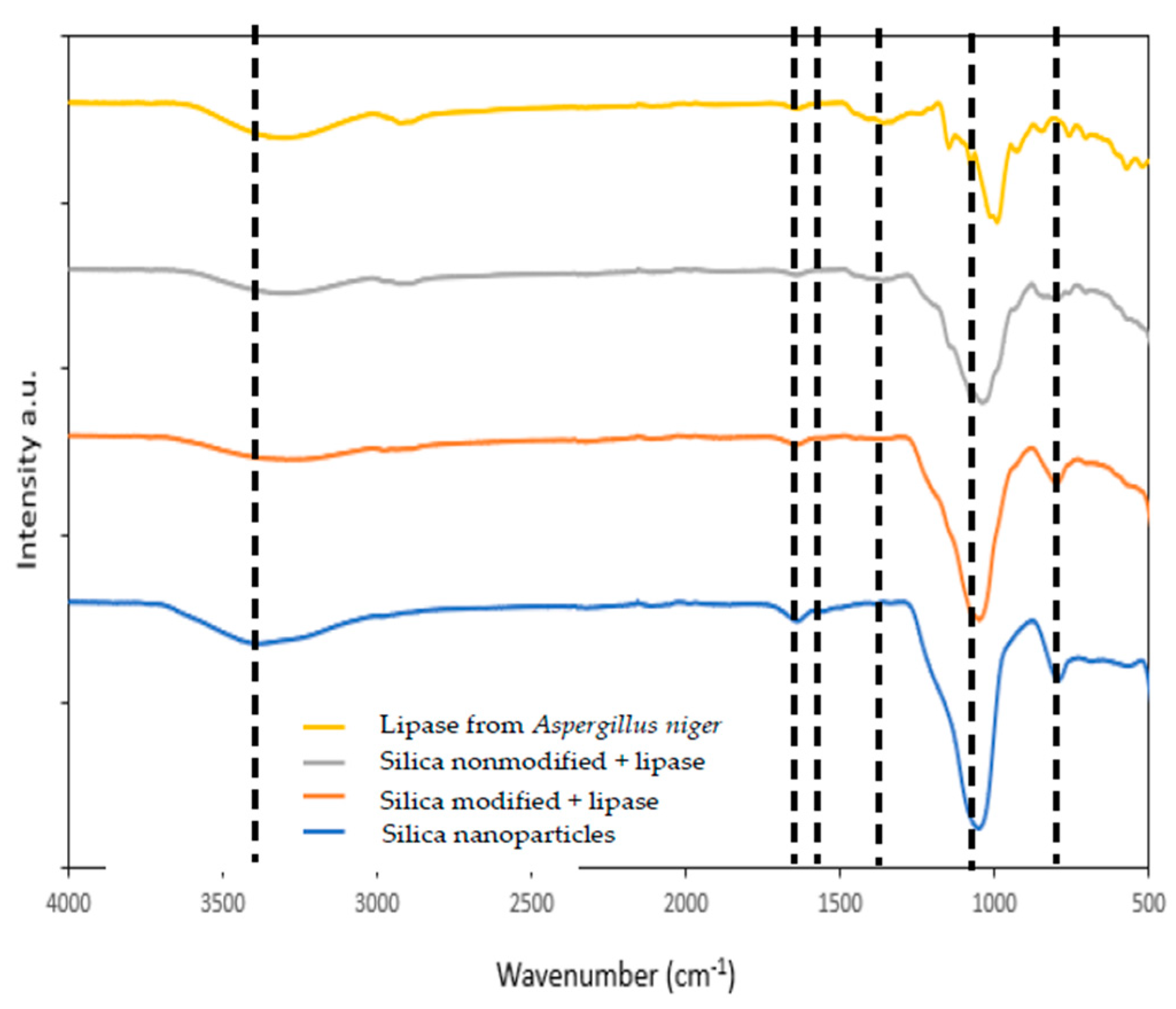
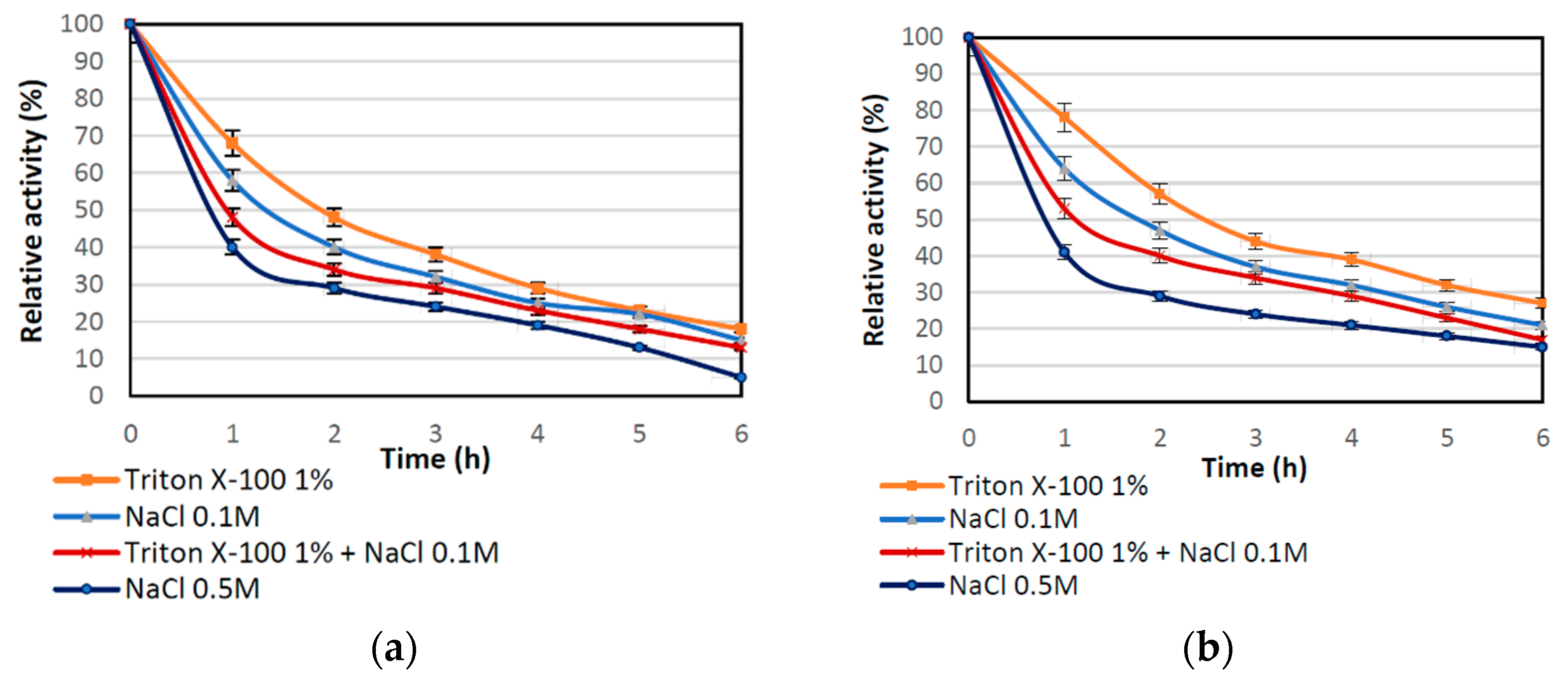
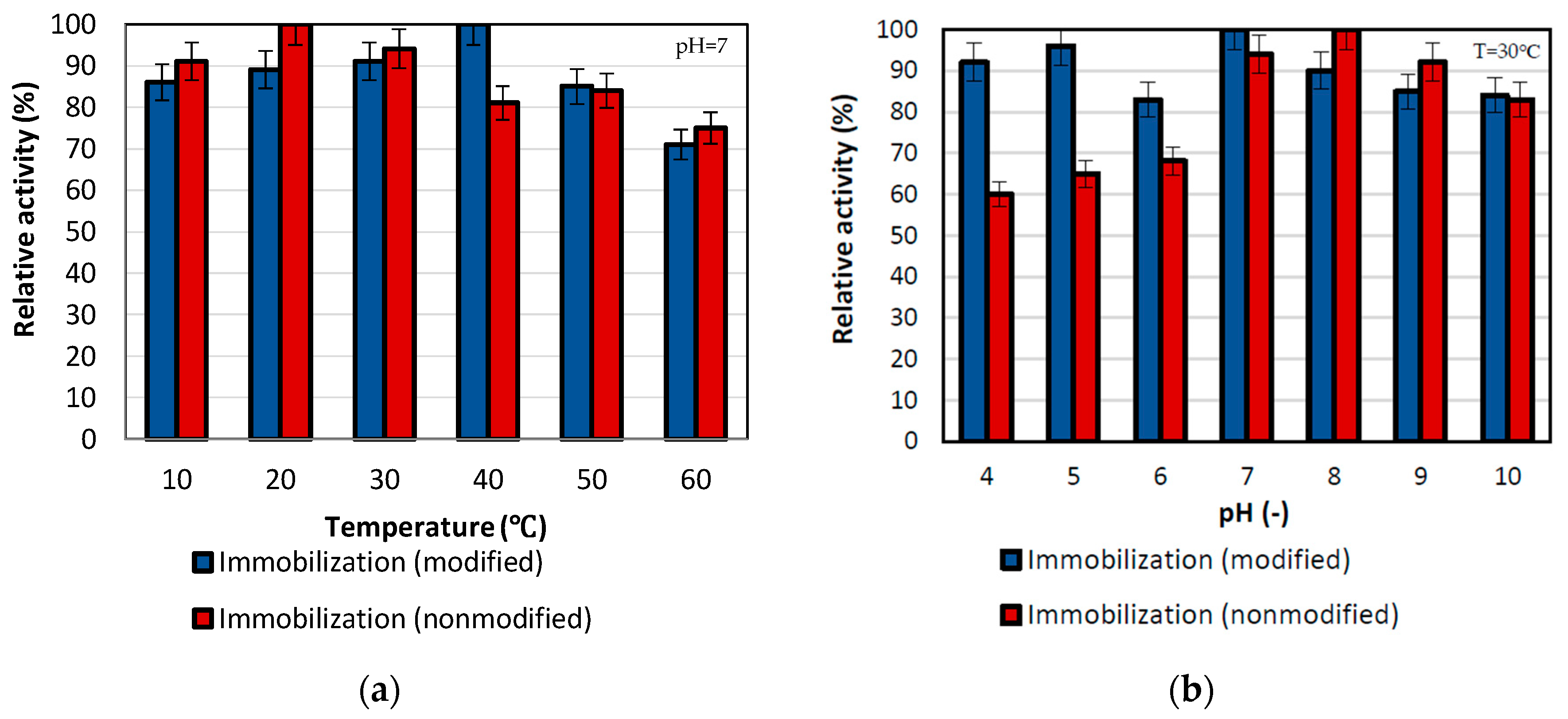


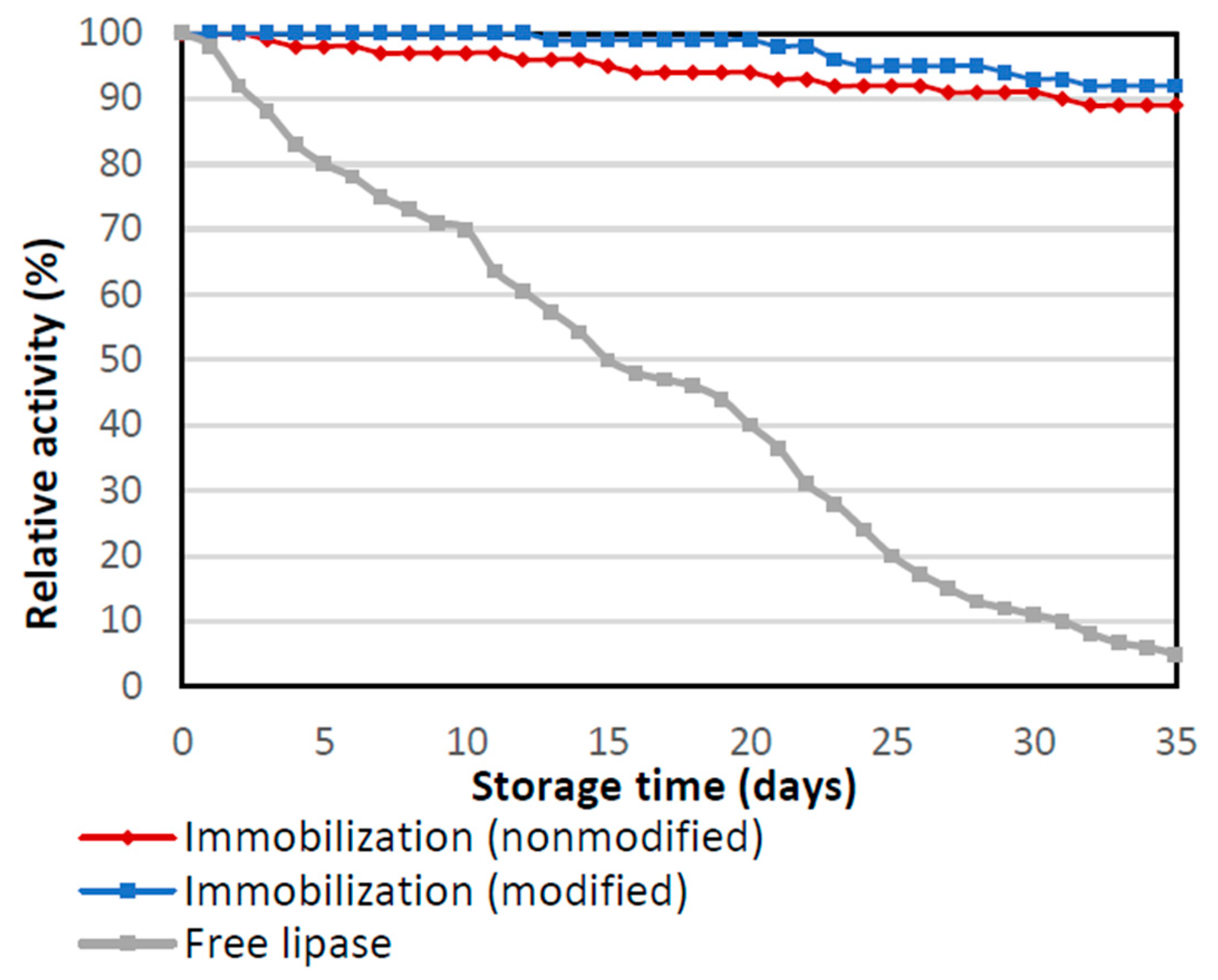
| Analyzed Parameter | Free Enzyme | Immobilization (Nonmodified) | Immobilization (Modified) |
|---|---|---|---|
| Immobilization yield (%) | - | 93 | 86 |
| Amount of immobilized enzyme (mg/g) | - | 205 | 187 |
| Specific activity (U/mg) | 57 | 53 | 49 |
| Activity recovery (%) | 100 | 90 | 87 |
| Type of Sample | PdI | Particle Size Range |
|---|---|---|
| Silica nanoparticles | 0.225 | 59–220 nm |
| Immobilized lipase (nonmodified) | 0.805 | 91–1106 nm |
| Immobilized lipase (modified) | 0.935 | 1484–6439 nm |
| Type of Eluent | Amount of Immobilized Enzyme (mg/g) | |
|---|---|---|
| Nonmodified Support | Modified Support | |
| Triton X-100 | 42.3 | 51.9 |
| NaCl 0.1 M | 29.7 | 32.4 |
| Triton X-100 1% + NaCl 0.1 M | 17.3 | 20.7 |
| NaCl 0.5 M | 8.3 | 10.1 |
| Immobilization Type | Amount of Enzyme (mg) | Solvent | Time (h) | Efficiency (%) | (R)-Ketoprofen ee (%) |
|---|---|---|---|---|---|
| Free lipase | 50 | PBS 7 | 96 | 21.7 | 99.7 |
| Nonmodified support | 10 | PBS 7 | 96 | 27.4 | 99.7 |
| Nonmodified support | 15 | PBS 7 | 96 | 46.3 | 99.9 |
| Nonmodified support | 20 | PBS 7 | 96 | 51.1 | 97.1 |
| Modified support | 10 | PBS 7 | 96 | 21.7 | 98.6 |
| Modified support | 15 | PBS 7 | 96 | 32.3 | 100.0 |
| Modified support | 20 | PBS 7 | 96 | 44.1 | 100.0 |
| Nonmodified support | 10 | PBS 7 | 24 | 23.3 | 99.5 |
| Nonmodified support | 15 | PBS 7 | 24 | 38.0 | 99.7 |
| Nonmodified support | 20 | PBS 7 | 24 | 45.4 | 98.8 |
| Modified support | 10 | PBS 7 | 24 | 20.2 | 100.0 |
| Modified support | 15 | PBS 7 | 24 | 29.7 | 99.8 |
| Modified support | 20 | PBS 7 | 24 | 40.3 | 98.1 |
| Nonmodified support | 10 | hexane | 24 | 46.0 | 98.9 |
| Modified support | 10 | hexane | 24 | 6.6 | 95.4 |
| Nonmodified support | 10 | diisopropyl ether | 24 | 19.8 | 98.8 |
| Modified support | 10 | diisopropyl ether | 24 | 9.9 | 96.9 |
| Nonmodified support | 10 | isopropanol | 24 | 12.4 | 98.6 |
| Modified support | 10 | isopropanol | 24 | 6.5 | 100.0 |
Publisher’s Note: MDPI stays neutral with regard to jurisdictional claims in published maps and institutional affiliations. |
© 2022 by the authors. Licensee MDPI, Basel, Switzerland. This article is an open access article distributed under the terms and conditions of the Creative Commons Attribution (CC BY) license (https://creativecommons.org/licenses/by/4.0/).
Share and Cite
Degórska, O.; Szada, D.; Zdarta, A.; Smułek, W.; Jesionowski, T.; Zdarta, J. Immobilized Lipase in Resolution of Ketoprofen Enantiomers: Examination of Biocatalysts Properties and Process Characterization. Pharmaceutics 2022, 14, 1443. https://doi.org/10.3390/pharmaceutics14071443
Degórska O, Szada D, Zdarta A, Smułek W, Jesionowski T, Zdarta J. Immobilized Lipase in Resolution of Ketoprofen Enantiomers: Examination of Biocatalysts Properties and Process Characterization. Pharmaceutics. 2022; 14(7):1443. https://doi.org/10.3390/pharmaceutics14071443
Chicago/Turabian StyleDegórska, Oliwia, Daria Szada, Agata Zdarta, Wojciech Smułek, Teofil Jesionowski, and Jakub Zdarta. 2022. "Immobilized Lipase in Resolution of Ketoprofen Enantiomers: Examination of Biocatalysts Properties and Process Characterization" Pharmaceutics 14, no. 7: 1443. https://doi.org/10.3390/pharmaceutics14071443
APA StyleDegórska, O., Szada, D., Zdarta, A., Smułek, W., Jesionowski, T., & Zdarta, J. (2022). Immobilized Lipase in Resolution of Ketoprofen Enantiomers: Examination of Biocatalysts Properties and Process Characterization. Pharmaceutics, 14(7), 1443. https://doi.org/10.3390/pharmaceutics14071443










